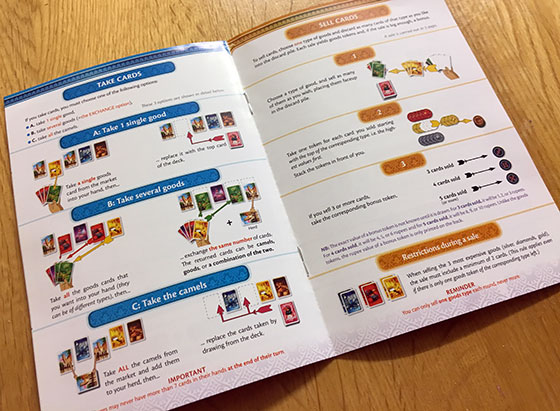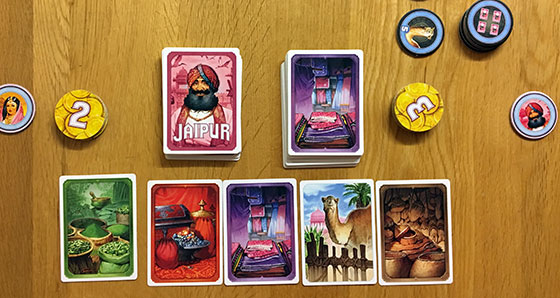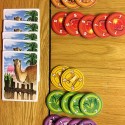‘Jaipur’ Board Game Review

Even though I’ve heard many good things about Jaipur over the years, the game has always eluded me. I play board games at many player counts and two player (with just my wife) is certainly one of them, but we tend not to focus on games designed for two players specifically. Jaipur is strictly a two player game, and so because I haven’t ever owned a copy and it’s unlikely to be produced at a games night (where the focus for warm up games tends to be on high player counts) I’ve simply never crossed paths with it.
Now, thanks to a reprint from Space Cowboys, I’ve finally got my hands on a copy of Jaipur, and my wife and I have been playing it constantly ever since. The first thing that I should say is that it lives up to the hype in every possible way, taking it from being something we were curious to try to being our go to two player game overnight. This is a fast, simple game that creates real tension and complex interaction between two players, without ever actually having them confront each other through take that or other cheap tricks that might put some players off.
At its heart, Jaipur is a set collection game that has some push your luck elements baked in for good measure. Players begin with a hand of cards and will assess an ever changing shared market, from which they will draw cards on most turns using one of three methods. With a maximum hand size of seven cards, the players will want to collect cards that match the six resources, with an aim to get as many resources of one kind into their hand as possible. When an appropriate number is reached, the player can spend their turn to “sell” those cards by discarding them and then taking a number of tokens that match the sold resource.
There are a few nuances to this, such as the fact that each stack of tokens that represent each type of goods has a decreasing value, meaning that the player who makes the first trade for a particular good will likely make more than the second player to sell the same good, even if that player sells more. With that said, there are secret bonus tokens for players making trades of three, four or five cards, each of which can offset the loss taken by not selling goods first. The push your luck aspect comes with players deciding whether to sell early or wait for a bigger sale.
To actually obtain resource cards, I mentioned that players have three options on their turn. Firstly, a player may simply take any face up card and then replenish the market with the next card from the deck. They may also swap goods, which can be done by taking any number of goods cards from the market, then replacing them with any goods in their hand, or camels in their herd (which I’ll explain in a moment.) The third action is to take camels – and when this action is taken, the player will claim all of the camel cards in the display and place them face up in front of them, rather than into their hand.

The efficient use of camels is one of the keys to victory in Jaipur, and knowing when to take camels rather than goods can be crucial. The reason why it is so important to have camels (aside from a five point bonus for the player who has most when the game ends) is the ability to trade a large number of camels for a large number of goods cards when the market is in your favour. It’s just as important to decide when to ditch camels as it is to decide when to take them, since you’ll unlikely ever get a perfect trade. Knowing when a trade is good enough is often the difference between winning and losing.
When three stacks of resource tokens are depleted, the game ends immediately. In less common scenarios, the game may also end when the market cannot be refreshed with the cards from the draw deck, but personally I’ve never seen that happen. Every game of Jaipur is played as a best of three, ensuring that pure luck of the draw will rarely decide the winner of the match, even if it does occasionally influence an individual turn within a single game. The luck aspect is purely down to the way in which cards are drawn, for example after one player takes all the camels and a large number of gold or gems might be revealed to fill the market.
A general lack of luck (or at least the fact that it affects both players equally) and the tight gameplay ensures that Jaipur is usually a close affair. Most games finish with the players on roughly equal points, and in most games, my wife and I shared between one hundred and forty and one hundred and seventy points. For such a high scoring game, it’s amazing that we seemed to finish close to each other on most occasions, but it also shows that Jaipur deserves its renown as a game that works so exceptionally well as a casual head to head game.

With its very fast playtime, quick turns, simple rules and very attractive pieces, as well as its small size, Jaipur is a must have for any fan of two player games. It has a friendly vibe and a gorgeous look that feels warm, colourful and opulent when laid on the table. Despite its soft appearance and simple rules, it’s also a smart, tight game that rewards clever planning and agile moment-to-moment thinking. A really superb game that we’ll be playing for a long time to come, and which I can’t wait to introduce to my friends.
****½ 4.5/5
Jaipur is available online at 365Games.co.uk, or at your local games store. Don’t know where yours is? Try this handy games store locator














































